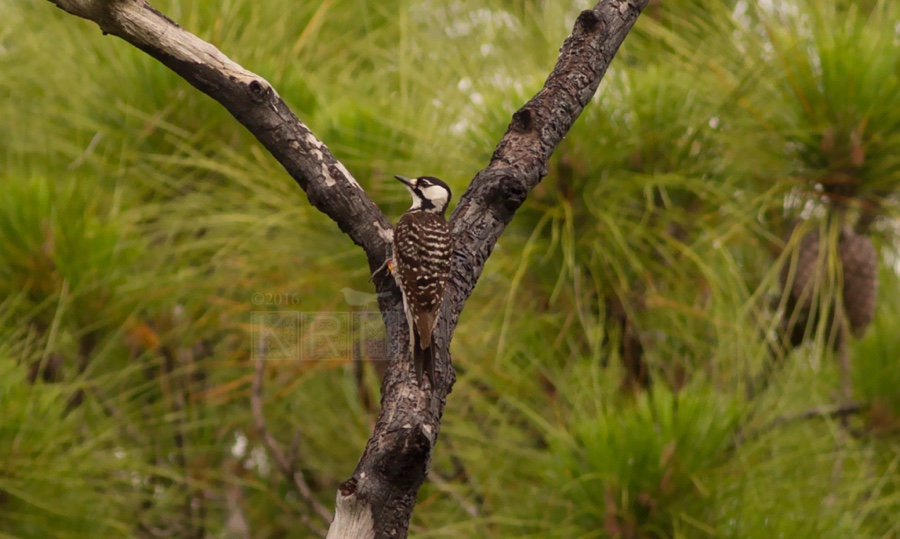
July’s Bird of the Month is the Red-cockaded Woodpecker, and here is the article in the upcoming July-August 2017 Kite written by Ben Kolstad.
Red-cockaded Woodpecker Picoides borealis FE (Federally Endangered)
This endangered woodpecker kicks off our series of Pine Woodland birds. Like the Florida Scrub-Jay, the RCWO is a social species that lives in family groups, often called clans, with a cooperative breeding system. Multiple generations of young remain in the cavity tree cluster and assist their parents in raising new broods of young. The factor responsible for this behavior is the lack of suitable nesting cavities in its preferred longleaf pine habitat. It takes an immense amount of effort and a long time (one to three years!) for these rather slight woodpeckers to excavate their nest. They are not equipped with the demolition tools of the Pileated Woodpecker, and they excavate in living, not dead, trees. They do this because the resin that exudes from excavations in live pine trees helps defend the nest from their most common predator, the rat snake, which loves to climb trees and prey on eggs and nestlings. The birds even drill extra resin-dripping holes above and below the nest entrance to ensure that there will be plenty of sticky resin (although sometimes things go wrong and the resin gets into the nest entrance itself, with lethal results for the birds that demonstrate such subpar engineering skills).
Efforts to reintroduce this species in areas where it has been extirpated (DuPuis, Corbett) have been relatively successful through the use of nest boxes installed into, rather than on, the tree. You can see a very good series of photos from one of the SFWMD press releases (the press release itself is no longer available online, as far as I can tell) about a recent wave of introductions of the birds at DuPuis.
Here’s a description of the bird, from a different SFWMD write-up about the reintroduction at DuPuis:
About the size of the common cardinal, the red-cockaded woodpecker is approximately 7 inches long (18 to 20 centimeters), with a wingspan of about 15 inches (35 to 38 centimeters). Its back is barred with black and white horizontal stripes. The red-cockaded woodpecker’s most distinguishing feature is a black cap and nape that encircle large white cheek patches. Rarely visible, except perhaps during the breeding season and periods of territorial defense, the male has a small red streak on each side of its black cap called a cockade, hence its name. The red-cockaded woodpecker feeds primarily on beetles, ants, roaches, caterpillars, wood-boring insects, and spiders, and occasionally fruits and berries.
(Photographer’s please note that next month’s August 2017 Bird will be the Bachman’s Sparrow)
Please check out the picture by Kenny Miller in the upcoming KITE featured at the beginning of this article and see the slide show of the entire photo gallery this month — click on BOM SLIDE SHOW below the pictures displayed here:
[flickr_set id=”72157685040797906″]
July 2017 Bird of the Month – Red-cockaded Woodpecker Slide Show


Comments are closed